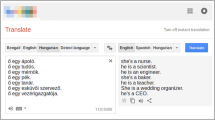Abstract
Since 1999, the Dutch Language Union (NTU) fosters the exchange of plans and policy initiatives amongst government officials of Flanders and the Netherlands on human language technology for Dutch (HLTD). One of the outcomes is the STEVIN R&D programme for HLTD, coordinated by the NTU and funded by the Flemish and Dutch governments. STEVIN is an example of successful joint research programming. Its set-up, highlights and scientific results are presented as well as an outlook to future initiatives.
Similar content being viewed by others
Notes
This argument, also called the modern Gütenberg effect, was taken up again by the recently published META-net Language White Paper Series (see http://www.meta-net.eu/whitepapers/) that advocates for more investments in HLT in Europe.
STEVIN, a Dutch acronym of ‘Spraak- en Taaltechnologische Essentiële Voorzieningen In het Nederlands’, stands for ‘Essential Speech and Language Technology Resources in Dutch’.
Daelemans et al. (2005) describe the BLARK for Dutch.
The acceptance rate for the open R&D project calls was between 26 and 33 %.
The HLT steering board comprised all the funding parties with some additional HLTD experts and supervised the entire programme.
The participating researchers receive a license that allows them to continue their research using “their” results. Companies receive a license for non-commercial use that allows for “personal research” using the results of the project the company participated in.
When the researchers are no longer able to maintain and distribute their sources, the HLT Agency takes over. Changing the type of open source license may be needed.
The CLARIN ERIC is a legal intergovernmental organisation that manages the CLARIN research infrastructure.
References
Daelemans, W., Binnenpoorte, D., et al. (2005). Establishing priorities in the development of HLT resources: The Dutch-Flemish experience. In W. Daelemans, T. du Plessis, C. Snyman & L. Teck (Eds.), Multilingualism and electronic language management: Proceedings of the 4th international MIDP Colloquium (pp. 9–23). Van Schaik, Bloemfontein.
D’Halleweyn, E., Odijk, J., Teunissen, L., & Cucchiarini, C. (2006). The Dutch-Flemish HLT programme STEVIN: Essential speech and language technology resources. In Proceedings of the 5th international language resources and evaluation (LREC’06), pp. 761–766.
Odijk, J. (Ed.). (2013). STEVIN programme project results. Utrecht.
Rehm, G., & Uszkoreit, H. (Eds.). (2012). Strategic research agenda for multilingual Europe 2020. Heidelberg: Springer.
Spyns, P. (2013). Essential speech and language technology for Dutch: Results by the STEVIN programme, chap introduction (pp. 1–17). Heidelberg: Springer.
Spyns, P., & D’Halleweyn, E. (2012). Smooth sailing for STEVIN. In Proceedings of the 8th international language resources and evaluation (LREC’12), Istanbul, pp. 1021–1028.
Spyns, P., & D’Halleweyn, E. (2013). Essential speech and language technology for Dutch: Results by the STEVIN programme, chap The STEVIN programme: Result of 5 years cross-border HLT for Dutch Policy Preparation, pp. 21–39. Heidelberg: Springer.
Spyns, P., & Odijk, J. (Eds.). (2013). Essential speech and language technology for Dutch: Results by the STEVIN programme. Heidelberg: Springer.
van Veenendaal, R., van Eerten, L., Cucchiarini, C., & Spyns, P. (2013). Essential speech and language technology for Dutch: Results by the STEVIN programme. Springer, Heidelberg, chap The Dutch-Flemish HLT Agency: Managing the Lifecycle of STEVIN’s Language Resources, pp. 381–394.
Váradi, T., Krauwer, S., Wittenburg, P., Wynne, M., & Koskenniemi, K. (2008). CLARIN: Common language resources and technology infrastructure. In Proceedings of the 6th international language resources and evaluation (LREC’08), Marrakech, pp. 1244–1248.
Acknowledgments
We thank our colleagues of the Nederlandse Taalunie, HLT steering board, HLT Agency and members of the various related working groups as well as the STEVIN programme office for their committed collaboration. In particular, we gratefully acknowledge Jan Odijk and Remco van Veenendaal for their comments. STEVIN results are presented on the STEVIN web site (http://www.stevin-tst.org/etalage) and are available via the HLT Agency (http://www.tst-centrale.org) as well as the CGN.
Author information
Authors and Affiliations
Corresponding author
Additional information
STEVIN was jointly funded by the Flemish and Dutch governments (http://www.stevin-tst.org).
Rights and permissions
About this article
Cite this article
Spyns, P., D’Halleweyn, E. Joint research coordination and programming for HLT for Dutch in the Low Countries. Lang Resources & Evaluation 47, 565–574 (2013). https://doi.org/10.1007/s10579-013-9225-4
Published:
Issue Date:
DOI: https://doi.org/10.1007/s10579-013-9225-4




